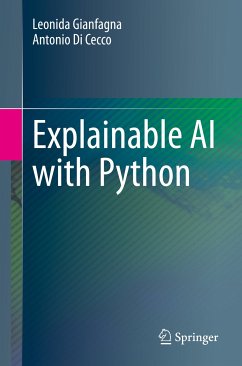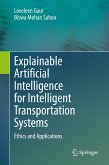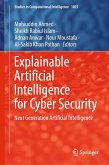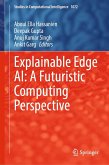

Alle Infos zum eBook verschenken

- Format: PDF
- Merkliste
- Auf die Merkliste
- Bewerten Bewerten
- Teilen
- Produkt teilen
- Produkterinnerung
- Produkterinnerung

Hier können Sie sich einloggen

Bitte loggen Sie sich zunächst in Ihr Kundenkonto ein oder registrieren Sie sich bei bücher.de, um das eBook-Abo tolino select nutzen zu können.
This book provides a full presentation of the current concepts and available techniques to make "machine learning" systems more explainable. The approaches presented can be applied to almost all the current "machine learning" models: linear and logistic regression, deep learning neural networks, natural language processing and image recognition, among the others.
Progress in Machine Learning is increasing the use of artificial agents to perform critical tasks previously handled by humans (healthcare, legal and finance, among others). While the principles that guide the design of these…mehr
- Geräte: PC
- ohne Kopierschutz
- eBook Hilfe
- Größe: 8.51MB
![Explainable Artificial Intelligence for Intelligent Transportation Systems (eBook, PDF) Explainable Artificial Intelligence for Intelligent Transportation Systems (eBook, PDF)]() Loveleen GaurExplainable Artificial Intelligence for Intelligent Transportation Systems (eBook, PDF)121,95 €
Loveleen GaurExplainable Artificial Intelligence for Intelligent Transportation Systems (eBook, PDF)121,95 €- -29%11
![Explainable Artificial Intelligence for Cyber Security (eBook, PDF) Explainable Artificial Intelligence for Cyber Security (eBook, PDF)]() Explainable Artificial Intelligence for Cyber Security (eBook, PDF)121,95 €
Explainable Artificial Intelligence for Cyber Security (eBook, PDF)121,95 € ![Explainable Edge AI: A Futuristic Computing Perspective (eBook, PDF) Explainable Edge AI: A Futuristic Computing Perspective (eBook, PDF)]() Explainable Edge AI: A Futuristic Computing Perspective (eBook, PDF)169,95 €
Explainable Edge AI: A Futuristic Computing Perspective (eBook, PDF)169,95 €![Explainable Agency in Artificial Intelligence (eBook, PDF) Explainable Agency in Artificial Intelligence (eBook, PDF)]() Explainable Agency in Artificial Intelligence (eBook, PDF)55,95 €
Explainable Agency in Artificial Intelligence (eBook, PDF)55,95 €![Case-Based Reasoning Research and Development (eBook, PDF) Case-Based Reasoning Research and Development (eBook, PDF)]() Case-Based Reasoning Research and Development (eBook, PDF)61,95 €
Case-Based Reasoning Research and Development (eBook, PDF)61,95 €![Explainable and Transparent AI and Multi-Agent Systems (eBook, PDF) Explainable and Transparent AI and Multi-Agent Systems (eBook, PDF)]() Explainable and Transparent AI and Multi-Agent Systems (eBook, PDF)40,95 €
Explainable and Transparent AI and Multi-Agent Systems (eBook, PDF)40,95 €![Explainable and Transparent AI and Multi-Agent Systems (eBook, PDF) Explainable and Transparent AI and Multi-Agent Systems (eBook, PDF)]() Explainable and Transparent AI and Multi-Agent Systems (eBook, PDF)46,95 €
Explainable and Transparent AI and Multi-Agent Systems (eBook, PDF)46,95 €- -24%11
-
-
This book provides a full presentation of the current concepts and available techniques to make "machine learning" systems more explainable. The approaches presented can be applied to almost all the current "machine learning" models: linear and logistic regression, deep learning neural networks, natural language processing and image recognition, among the others.
Progress in Machine Learning is increasing the use of artificial agents to perform critical tasks previously handled by humans (healthcare, legal and finance, among others). While the principles that guide the design of these agents are understood, most of the current deep-learning models are "opaque" to human understanding. Explainable AI with Python fills the current gap in literature on this emerging topic by taking both a theoretical and a practical perspective, making the reader quickly capable of working with tools and code for Explainable AI.
Dieser Download kann aus rechtlichen Gründen nur mit Rechnungsadresse in A, B, BG, CY, CZ, D, DK, EW, E, FIN, F, GR, HR, H, IRL, I, LT, L, LR, M, NL, PL, P, R, S, SLO, SK ausgeliefert werden.
- Produktdetails
- Verlag: Springer International Publishing
- Seitenzahl: 202
- Erscheinungstermin: 28. April 2021
- Englisch
- ISBN-13: 9783030686406
- Artikelnr.: 61667379
- Verlag: Springer International Publishing
- Seitenzahl: 202
- Erscheinungstermin: 28. April 2021
- Englisch
- ISBN-13: 9783030686406
- Artikelnr.: 61667379
- Herstellerkennzeichnung Die Herstellerinformationen sind derzeit nicht verfügbar.
Antonio Di Cecco is a theoretical physicist with a strong mathematical background that is fully engaged on delivering education on AIML at different levels from dummies to experts (face to face classes and remotely). The main strength of his approach is the deep-diving of the mathematical foundations of AIML models that open new angles to present the AIML knowledge and space of improvements for the existing state of art. Antonio has also a "Master in Economics" with focus innovation and teaching experiences. He is leading School of AI in Italy with chapters in Rome and Pescara







